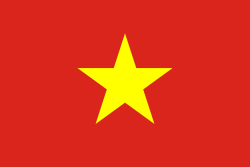Prezidentský palác (Hanoj)
| Prezidentský palác | |
|---|---|
 | |
| Účel stavby | |
oficiální sídlo | |
| Základní informace | |
| Sloh | italská renesance |
| Architekt | Auguste Henri Vildieu |
| Poloha | |
| Adresa | Hanoj, |
| Souřadnice | 21°2′20″ s. š., 105°50′3″ v. d. |
| Další informace | |
| Některá data mohou pocházet z datové položky. | |

Prezidentský palác v Hanoji je vládní budova, postavená v letech 1900 až 1906 jako rezidence generálního guvernéra Francouzské Indočíny. Byl postaven na návrh francouzského architekta Augusta Henri Vildieua. Poté, co Vietnam získal v roce 1954 nezávislost, Ho Či Min odmítl v paláci ze symbolických důvodů přebývat a bydlel v domku, postaveném v areálu paláce. Dnes je palác využíván pro účely vietnamské vlády.
Odkazy
Externí odkazy
 Obrázky, zvuky či videa k tématu Prezidentský palác na Wikimedia Commons
Obrázky, zvuky či videa k tématu Prezidentský palác na Wikimedia Commons
Média použitá na této stránce
Map of Hanoi after the First World War. The descriptions are in Czech.
(c) I, Ondřej Žváček, CC BY 2.5
Prezidentský palác v Hanoji (Vietnam).
Autor: Jorge Láscar, Licence: CC BY-SA 2.0
The Presidential Palace of Vietnam, located in the city of Hanoi, was built between 1900 and 1906 to house the French Governor-General of Indochina. It was constructed by Auguste Henri Vildieu, the official French architect for Vietnam. Like most French colonial architecture, the palace is pointedly European- the only visual cues that it is located in Vietnam at all are mango trees growing on the grounds. The striking yellow palace stands behind wrought iron gates flanked by sentry boxes. It incorporates elements of Italian Renaissance design, including: * aedicules * a formal piano nobile reached by a grand staircase * broken pediments * classical columns * quoins When Vietnam achieved independence in 1954, Ho Chi Minh refused to live in the grand structure for symbolic reasons, although he still received state guests there, and he eventually built a traditional Vietnamese stilt house and carp pond on the grounds. Today, Ho Chi Minh's Mausoleum stands nearby and the Presidential Palace remains part of Hanoi's cultural core. The palace hosts government meetings. It is not open to the public, although one may walk around the grounds for a fee. [Wikipedia.org]




